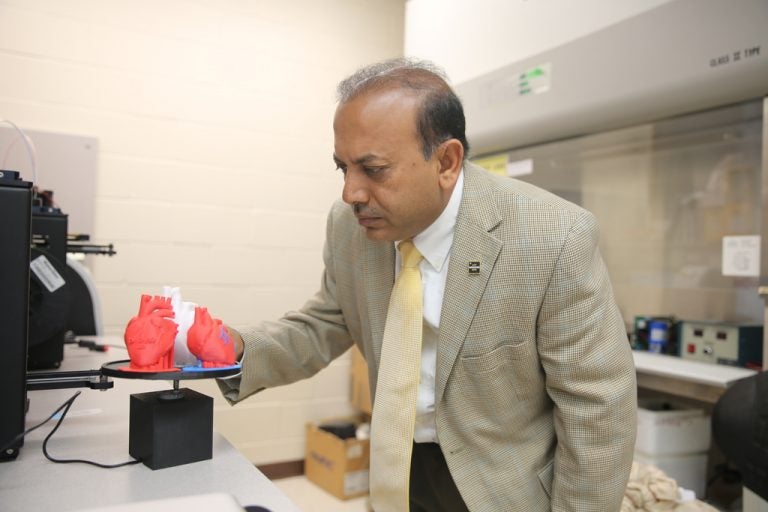It’s scary enough to be told your child has a heart problem. It’s even worse when the doctor says open-heart surgery is necessary.
Imagine trying to fix a faulty valve in the body of a 9-month-old. To help physicians better prepare for that kind of delicate surgery, University of Central Florida biomedical sciences professor Dinender Singla has created a way to produce customized 3-D printed hearts that can be used for practicing surgery techniques.
“The goal is to give doctors a tool they can use that accurately reflects what they will be seeing when they go into surgery,” Singla said. “It can make for better outcomes.”
Singla and undergraduate students in his lab have produced several prototype hearts and hope to get funding to start producing workable models.
CT or MRI scans are fed into a software program that turns the two-dimensional images into 3-D coordinates. Those coordinates are then sent to a 3-D printer, which spends from four to seven hours printing the heart. Time varies depending on the heart problem of the individual patient. Problems on the outside of the heart or with the valves feeding blood to the muscle take less time to produce than those that reflect delicate internal structural problems.
The hearts can be printed with a variety of materials – hard polymers or softer material to more realistically demonstrate structural and internal defects. The hearts can also be color coded to make congenital defects stand out.
“It’s pretty amazing work,” said Kaley Garner, a biomedical sciences and biotechnology major working in Singla’s lab. Garner was instrumental in connecting the engineering and medical components of the project. “Heart disease is such a big issue now for adults and children. I love that I get to make models that could help doctors prepare for surgery.”
Jessica Hellein, another student in Singla’s lab, said she’s eager to see their lab research used to help children. Singla and his team is working with Dr. William DeCampli, a pediatric surgeon at Arnold Palmer Hospital for Children and a faculty member at the UCF College of Medicine. The technique could easily be adapted to model adult-sized hearts, as well.
In addition to making patient-specific disease models, 3-D technology opens up a host of other possibilities, one of which is 3-D bioprinting. That process involves using stem cells in a complicated process to create artificial organs, a developing field that Singla has been working in for the past 15 years.
He’s not alone. In February, the Wake Forest Institute for Regenerative Medicine published research about its work. Researchers there were able to 3-D bioprint human ears and then transplant them onto mice. After several months the ears had kept their shape and blood vessels were feeding the cells in the artificial ears.
“These are exciting times in bioengineering, which could eventually end the need for organ donors,” Hellein said. “Over the past 20 years, technology has improved rapidly, and it will be exciting to see where we are within the coming decades. There’s a long way to go, but projects like these are a start.”
